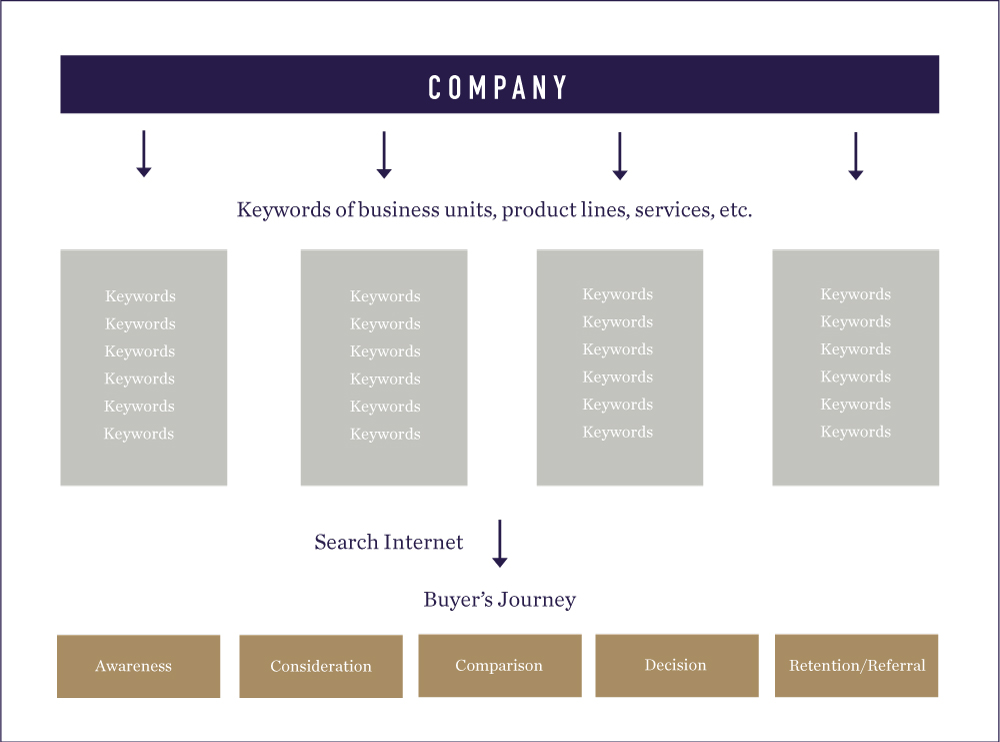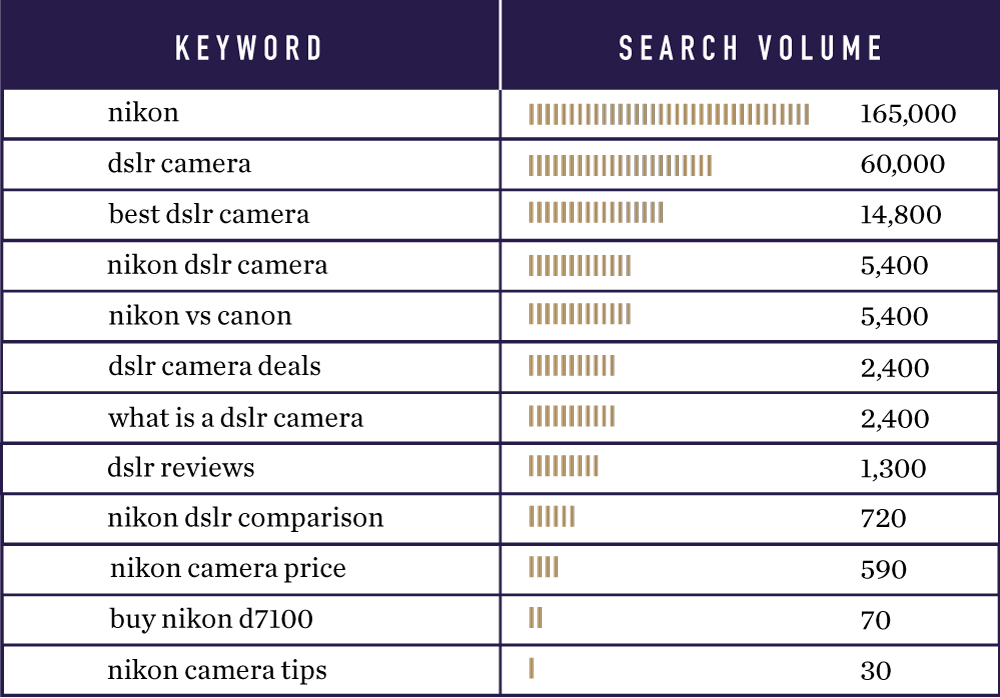As more companies invest time and effort into content creation and paid marketing, marketing departments are facing an increasingly common problem of getting and targeting the right users with keywords. With increased competition, it’s important to provide the right content to users while they are searching. Easier said than done, sure.
Still, there is a way to address these pains with one simple concept: using search intent to map your keywords to the buyer’s journey. According to Google, search intent (i.e., understanding what your prospective customers are really looking for when they enter a particular search term or phrase into a search engine) is a much better predictor of future behavior than demographic data. Since most of you reading this post won’t be executing content strategies yourselves, I want to discuss what search intent is, why it’s important, and how you should be using it to better understand and respond to your buyer’s journey.
The Rise of Search Intent
If you’re just coming to terms with the reality that your buyer is heavily using digital channels to find information about you prior to interacting with you, you’re probably at least six years behind most of your competitors. These channels are continuing to evolve beyond simple Google searches; the perfect example of this evolution is intelligent voice assisted devices. These voice assisted devices are growing in popularity and are integrating into more and more of our electronic devices. What was first limited to our smartphones has now expanded to our computers, completely new devices (like the Amazon Echo), and more recently to previously unconnected parts of your home and car, from your refrigerator to your security system. Always listening, always available.
The growth of these devices seems to be skyrocketing in 2016 – with no end in sight. One common theme between these devices is their need to understand the intent in queries. When you’re on the road and you’re asking Siri to look up Mexican restaurants, you’re probably looking for a restaurant near you, not one 200 miles away. While users of these voice assistants are being trained to provide queries with intent to get the best possible results, the devices themselves are getting better at assuming intent. This means that the underlying search engines that complement them are getting more intelligent as well.
Evolution in Search
The ability to perform a search is easier than ever due to mobile devices. With information always being readily available, the importance of search engines’ ability to understand intent has increased. Users are becoming more demanding of relevant and quality results for any search.
An article published on the “think with Google” blog describes in detail a consumer’s journey during the car-buying process. The article states that the user went through over 900 digital interactions during the process. With many of these interactions, the searches could be broken down into different micro-moments to better understand the intent.
Understanding the intent behind the user’s search can help brands provide the right content, at the right time, in the right place. But doing so requires a complex, multi-channel strategy: something that isn’t created overnight.
Breaking Down Search Intent
Understanding the intent behind why people are searching can help you gain an understanding of how to optimize your keywords for better performance in search engine results. Having content that is aligned with search intent can not only lead to better click-through rates, but it also adds more value to the user. Providing the right content at the right time and in the right place is not only beneficial for search engines (who want to be able to assure reliable results), but can also help to establish user trust with your brand.
Search intent can be broken down into four different categories. We will use DSLR cameras as an example of possible search queries from a user.
Navigational
These searches are often used to help a user navigate to a predetermined destination. The user might not know the exact URL address of a brand, so they search Google to get a link to the website. The value of these searches is typically very low.
Example: A user may search “Nikon website,” where the results would then provide an address for Nikon’s homepage.
Informational
As the name suggests, these searches are typically made for informational purposes. There is little commercial or transactional intent behind them, and the value of these keywords is typically low.
Example: A user may search for something like “Photography Tips” where results are tips and tricks for becoming a better photographer.
Commercial Investigative
Commercial investigative search queries are typically for the use of research during the purchase process. These searches are often used to inform the purchase decision. The value of these keywords is typically between that of informational and transactional keywords (middle value).
Example: A user may search for “best DSLR cameras” to gain insight on the differences between similar products and brands.
Transactional
As you may have guessed by the name, these searches are used when the purchase decision has been made and the user intends to buy. The value of these keywords is typically high.
Example: A user may search for “Buy Canon DSLR camera” to get a list of websites that sell this brand’s product.
Using Search Intent to Build a Buyer’s Journey
Once you understand the differences in search intent, you can then begin to map your keywords to build your buyer’s journey using intent as a guide. This visualization demonstrates a suggested workflow for this mapping process:
To carry out this mapping process, you need to have a deep understanding of your organization’s business units, product lines, and services offered. This includes knowing which needs or wants each business unit fulfills for your customers or end users.
Using our camera example again, we can use Nikon’s line of DSLR cameras to generate a single group of keywords. We know Nikon likely wants to sell more cameras, but within this group, we want to keep in mind all possible pain points a consumer searching for a camera might want to address.
Let’s compile a short example list of keywords related to users searching for Nikon DSLR cameras.
Here are three simple ways to generate keywords (again, the purpose of this exercise is to help you understand the why, not a deep-dive into the how):
- Look through your own website to understand your business units
- Use tools like Google AdWords Keyword Planner and SEMRush to find related keywords
- Think like your potential customers would and try different search terms yourself
There are dozens of other ways to generate your keyword list, but this is an easy start. During this process, we also want to filter out keywords that irrelevant, as they add little value to the user searching (e.g. Canon tripods), and we don’t want that.
After generating a list of keywords related to Nikon and what users are likely searching for pertaining to DSLR cameras, we pulled the search volume using Google AdWords Keyword Planner. There appears to be a large fluctuation in search volume, but don’t be tempted to focus on those higher-traffic keywords right away. While we map the keywords to the buyer’s journey, with search intent as a guide, you’ll see why the lower-volume keywords are still important. Let’s go through each phase of the buyer’s journey and list the keywords that would be associated with them.
Awareness
The awareness stage is where the consumer needs a solution to a problem and can learn you provide it. The keywords “dslr camera” and “what is a dslr camera” would fall into this stage, as the intent is informational and the user may want to learn more about these types of cameras. Also, the keyword “Nikon” would likely fit here as the intent is navigation and the user may still be learning what your product provides.
Consideration
The consideration stage is when a consumer is evaluating how this solution could meet their need and whether it’s right for them. The keywords “nikon dslr camera,” “dslr camera deals,” “dslr reviews,” and “best dslr camera” fit here as the search intent is commercial investigative and consumers are researching Nikon as well as potentially other brands.
Comparison
The comparison stage is where the consumer is exploring which solution is best for them. The keywords “nikon dslr comparison,” “nikon vs canon,” and “nikon camera price” would be here as the intent is commercial investigative and indicates the user is comparing products.
Decision
The decision stage is where the consumer has selected your solution and is ready to buy. The keyword that fits in this category would be “buy nikon d1700” as the intent is transactional and indicates that the user is ready to purchase.
Retention/Referral
Once your customer has made their purchasing decision, they’ve entered the retention/referral phase of the buyer’s journey. Keywords here should focus on cross-selling and up-selling, deepening brand loyalty, and helping buyers to better use your products or services. The keyword “nikon camera tips” has a search intent of informational and the user wants to learn more about their new product.
Conclusion
Ultimately, using search intent to map keywords to your buyer’s journey is only one step towards improving your content strategy. But it’s an important step. The difference between a company that anticipates their buyers’ interests and one that only reacts to them can translate to millions of dollars in gained or lost revenue.
I don’t want to oversimplify how challenging it is to stay on top of these efforts: it’s incredibly hard, and generally it takes a really good agency or an experienced in-house SEO or content strategist to do it well. But if your company can successfully navigate this challenge, the increased relevancy of your content and your paid efforts will provide a better search experience for your customers and will add a tremendous amount of value to your brand. Don’t let these dollars pass you by.







